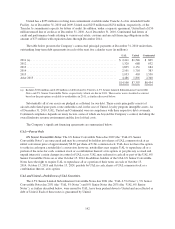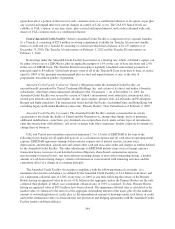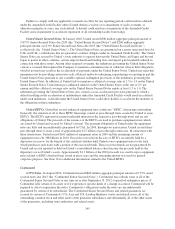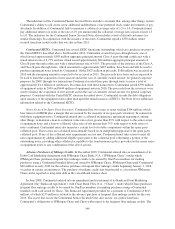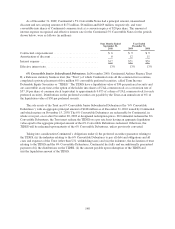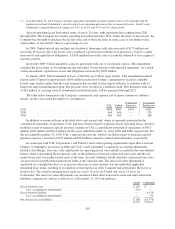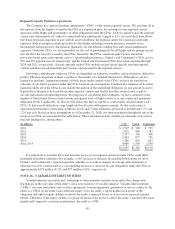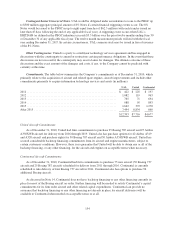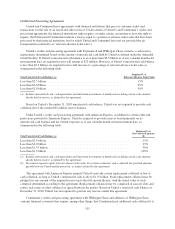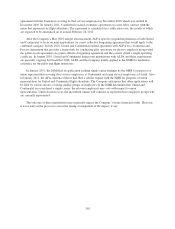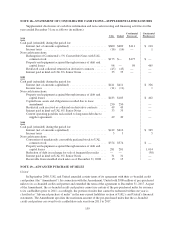United Airlines 2010 Annual Report Download - page 153
Download and view the complete annual report
Please find page 153 of the 2010 United Airlines annual report below. You can navigate through the pages in the report by either clicking on the pages listed below, or by using the keyword search tool below to find specific information within the annual report.
Regional Capacity Purchase Agreements
The Company has capacity purchase agreements (“CPAs”) with certain regional carriers. We purchase all of
the capacity from the flights covered by the CPA at a negotiated price. In exchange for the regional carriers’
operation of the flights and performance of other obligations under the CPAs, we have agreed to pay the regional
carrier a pre-determined rate, subject to annual inflation adjustments (capped at 3%), for each block hour flown
(the hours from gate departure to gate arrival) and to reimburse the regional carrier for various pass-through
expenses (with no margin or mark-up) related to the flights, including aviation insurance, property taxes,
international navigation fees, depreciation (primarily aircraft-related), landing fees and certain maintenance
expenses. Under the CPAs, we are responsible for the cost of providing fuel for all flights and for paying aircraft
rent for all of the aircraft covered by the CPAs. Generally, the CPAs contain incentive bonus and rebate
provisions based upon each regional carrier’s operational performance. United’s and Continental’s CPAs are for
295 and 252 regional aircraft, respectively, and the United and Continental CPAs have terms expiring through
2024 and 2021, respectively. Aircraft operated under CPAs include aircraft leased directly from the regional
carriers and those leased from third party lessors and operated by the regional carriers.
Our future commitments under our CPAs are dependent on numerous variables, and are therefore difficult to
predict. The most important of these variables is the number of scheduled block hours. Although we are not
required to purchase a minimum number of block hours under certain of our CPAs, we have set forth below
estimates of our future payments under the CPAs based on our assumptions. Continental’s estimates of its future
payments under all of the CPAs do not include the portion of the underlying obligation for any aircraft leased to
ExpressJet or deemed to be leased from other regional carriers and facility rent that are disclosed as part of
aircraft and nonaircraft operating leases. For purposes of calculating these estimates, we have assumed (1) the
number of block hours flown is based on our anticipated level of flight activity or at any contractual minimum
utilization levels if applicable, (2) that we will reduce the fleet as rapidly as contractually allowed under each
CPA, (3) that aircraft utilization, stage length and load factors will remain constant, (4) that each carrier’s
operational performance will remain at historic levels and (5) that inflation is projected to be between 1.5% and
2.2% per year. Based on these assumptions as of December 31, 2010, our future payments through the end of the
terms of our CPAs are presented in the table below. These amounts exclude variable pass-through costs such as
fuel and landing fees, among others.
(In millions) UAL United Continental
2011 ............................................................. $ 1,707 $ 908 $ 799
2012 ............................................................. 1,622 840 782
2013 ............................................................. 1,557 791 766
2014 ............................................................. 1,403 677 726
2015 ............................................................. 1,286 619 667
After 2015 ........................................................ 4,080 1,550 2,530
$11,655 $5,385 $6,270
It is important to note that the actual amounts we pay to our regional operators under CPAs could differ
materially from these estimates. For example, a 10% increase or decrease in scheduled block hours for all of
United’s and Continental’s regional operators (whether as a result of changes in average daily utilization or
otherwise) in 2011 would result in a corresponding increase or decrease in cash obligations under the CPAs of
approximately $478 million (8.2%) and $77 million (9.6%), respectively.
NOTE 16—VARIABLE INTEREST ENTITIES
Variable interests are contractual, ownership or other monetary interests in an entity that change with
fluctuations in the fair value of the entity’s net assets exclusive of variable interests. Variable interest entities
(“VIEs”) can arise from items such as lease agreements, loan arrangements, guarantees or service contracts. An
entity is a VIE if (a) the entity lacks sufficient equity or (b) the entity’s equity holders lack power or the
obligation and right as equity holders to absorb the entity’s expected losses or to receive its expected residual
returns. Therefore, if the equity owners as a group do not have the power to direct the entity’s activities that most
significantly impact its economic performance, the entity is a VIE.
151



